A Fan Remembers: Hagler vs. Hearns – part 1
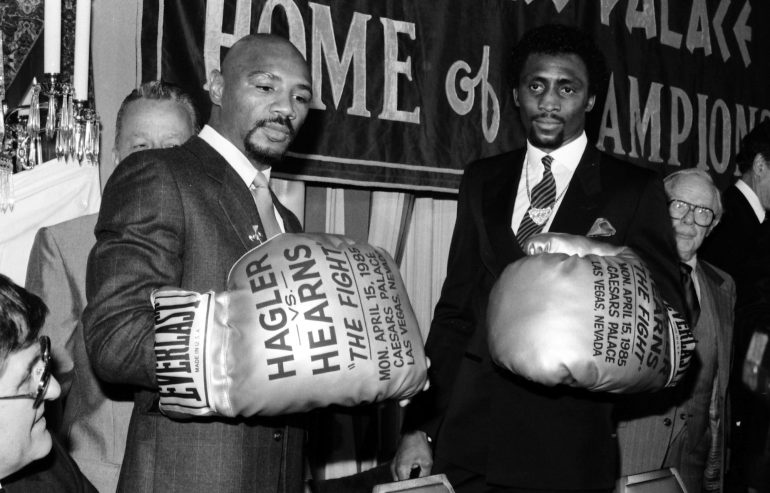
Thirty five years ago this week, Marvelous Marvin Hagler and Thomas Hearns surpassed the highest of expectations and put forth a brawl for the ages. Their seven minutes and 52 seconds of unforgettable fury included arguably the greatest first round in championship annals and a finish that was vigorous, violent and beyond argument. With the victory, Hagler cemented his status as an elite crossover superstar while Hearns honored himself in this, his second professional defeat in 42 contests.
One of the best tributes a pairing can receive is to have the participants’ surnames linked by a hyphen, but it is an even higher honor for that hyphenated label to become synonymous with the best boxing has to offer. Say “Hagler-Hearns” to a boxing fan, and that person will know exactly what brand of combat is being referenced. It was true then, and it is true now: Hagler-Hearns is a fight that will forever stand the test of time.
On April 15, 1985, yours truly was a 20-year-old sophomore at Fairmont State College but had already logged plenty of time as a boxing fan – a little more than 11 years to this point. Like most, I followed the exploits of “The Marvelous One” and “The Hit Man” since the late-1970s thanks to the articles I read in the magazines and the fights I watched on ABC, NBC and CBS. Because the fight was staged on a Monday night – and because I didn’t have easy access to a closed-circuit venue – I was not able to see the fight live. I had to seek out radio updates on fight night, then newspaper accounts the following morning, to get an idea of the mayhem that unfolded in the open-air arena at the parking lot of Caesars Palace. Once I realized the magnitude of what occurred, I knew I had missed out on something very special. When I viewed the replay on “ABC’s Wide World of Sports,” I was enthralled by what I saw, but because I knew the details of what was to occur, I was denied that one-of-a-kind thrill those who saw it live must have felt.
This was a fight that was several years in the making, and, in hindsight, this showdown served to fill the gaps that would eventually become the legend of Marvelous Marvin Hagler. It is this fight, more than any other, that cemented him as a blue-collar hero who touched the stars through old-fashioned hard work, sacrifice and determination. His story resonates with everyone who had to start from the bottom and who had to travel the longest, hardest roads to earn that one opportunity that would take him to the doorstep of all of his dreams.
For Hagler, that doorstep was his initial title shot against then undisputed middleweight champion Vito Antuofermo in November 1979, an opportunity that occurred in Hagler’s 50th professional fight and only after years of calling out the contenders and champions who wisely avoided him. Following a disputed draw against the man he derisively called “Vito the Mosquito,” Hagler feared he would never get a second chance, but because so many felt he should have been declared the winner against Antuofermo he was allowed to approach the doorstep a second time against
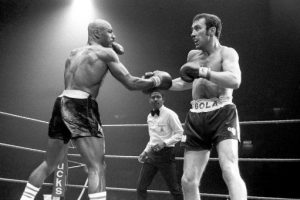
Marvelous Marvin Hagler (left) vs. Alan Minter. Photo credit: S&G and Barratts/EMPICS Sport
Antuofermo’s successor Alan Minter, but he had to do so in Minter’s home country of England before a raucous, drunken and nationalistic audience. This time, Hagler lived up to his “destruct and destroy” motto by gashing Minter’s face and pummeling him from pillar to post, but even after he was declared the winner on cuts in round three he never got the chance to fully celebrate his mountaintop moment. That was because the infuriated crowd hurled bottles toward the ring, and because some of them hit their targets, Hagler and his team were forced to run out of the ring. Because of this, Hagler was made to feel like a thief instead of a freshly minted undisputed world champion, and this denial only served to fuel the bitterness and paranoia that animated him.
Over the next three years, Hagler disposed of every challenger placed in front of him – Fulgencio Obelmejias (twice), Antuofermo (in a rematch), Mustafa Hamsho, William “Caveman” Lee, Tony Sibson and Wilford Scypion – and he dismissed each of them inside the distance. By doing so, he fulfilled the visions many had of him as a dominant champion, but he also prompted questions of how he would perform on the biggest stages, under the brightest lights, and against his most celebrated peers. By taking care of the sextet listed earlier in this paragraph, it became clear that his defining opponent would have to come from another weight class, and with a move up to 175 not a viable option, Hagler looked down the scale – and, in the case of one potential foe, down at the HBO commentary table.
If Hagler had his druthers, his first choice would have been the man who was wearing the headsets – Sugar Ray Leonard. A little less than two months after Hagler destroyed Minter, Leonard regained his WBC welterweight championship, then added to his legend by beating puzzling left-hander Larry Bonds, undefeated WBA super welterweight king Ayub Kalule, undefeated WBA welterweight champion Thomas Hearns and NABF welterweight titlist Bruce Finch. But a retinal tear suffered while prepping for a fight against mandatory challenger Roger Stafford moved Leonard to announce his retirement and to invest his full focus on his broadcasting career, a career that had him ringside for many of Hagler’s title defenses. Despite Leonard’s out-of-the-ring role, the competitive tension between the two was unmistakable and the sight of the young and still trim Leonard standing alongside the freshly victorious Hagler inspired powerful yearnings for this dream match to be made real. Hagler wanted it and the fans wanted it, but Leonard, who was always one statement away from making it happen, remained on the sideline.
With the Leonard match a seemingly unreachable fantasy, Hagler and his team turned their attention toward Hearns, who rebounded from his historic defeat against Leonard by scoring a 10-round decision over Ernie Singletary on the Muhammad Ali-Trevor Berbick undercard and a surprisingly short 108-second destruction of Marcos Geraldo in February 1982. Scaling 155 and 153¼ for those bouts, Hearns proved he could carry his talent – and his power – up the scale, and his blend of height, reach, single-shot power, name recognition and next-level versatility established him as the next best thing to Leonard as far as dream opponents. Unlike Leonard, the 23-year-old Hearns was ready, willing and able to step forward, accept the challenge, and grant Hagler the big stage – and the big money – he so dearly wanted.
The match was scheduled to take place May 24, 1982, two months after Hagler crushed Lee in 67 seconds and nearly three months after Hearns wiped out Geraldo. But an injury to Hearns’ vaunted right hand caused the fight to be rescheduled for July 12, then cancelled altogether.
With his first chance at a superstar fighter snatched from his grasp through no fault of his own, Hagler was incensed.
“He was going to make $2 million and then he turned down $2 million,” he griped. Then, with his voice dripping with sarcasm, he added the following: “He started complaining about his little baby pinkie. Do you know how many people would give a million dollars for that little baby pinkie? They’d cut that thing off.”
With the Hearns fight gone, Hagler continued to go about his business by stopping Obelmejias in their second meeting, then Sibson and Scypion. Meanwhile, another future member of “The Four Kings” — and the man who would become Hagler’s first signature opponent — was authoring a most improbable comeback.

Leonard got his revenge over Duran in New Orleans. Photo/ THE RING
Roberto Duran was the man from whom Leonard regained his WBC welterweight title two months after Hagler became middleweight champion, and he surrendered that title in most ignominious fashion. Minutes after a seventh round in which Leonard humiliated Duran with a series of showboating moves – including a fake bolo/jab-to-the-face that drew horselaughs from ringsiders – Duran, the high priest of machismo, turned his back, threw up his gloves and quit. That single act erased a reputation that had been built over 73 fights and nearly 13 years. The man-demon who earned such raves during his six-and-a-half-year lightweight title reign and following his savage unanimous decision victory over Leonard five months earlier was now a pariah in his home country of Panama as well as a global punch-line. Though he never said the words “no mas” to referee Carlos Padilla, the phrase became an indelible part of the sports lexicon.
It was from these ashes that Duran rebuilt his career, and the road he took included several potholes. Back-to-back decision victories over Nino Gonzalez and Luigi Minchillo were followed by back-to-back defeats to the excellent Wilfred Benitez (the WBC super welterweight champion) and the gifted but confounding Kirkland Laing. That loss relegated Duran to the “walkout bout” slot on the card topped by the first Aaron Pryor-Alexis Arguello fight, and during his 10-round decision win over Jimmy Batten, Duran had the look of a past-his-prime rock-and-roller playing a dive bar. Promoter Don King jettisoned Duran’s contract, and, at the relatively tender age of 31, Duran looked through.
But rival promoter Bob Arum believed that a motivated Duran could become a rejuvenated Duran. By taking a chance on the dispirited former champion, Don King’s trash ended up being Bob Arum’s treasure.
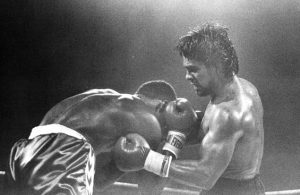
Duran took Davey Moore to the school of hard knocks.
Presented with the opportunity to face Pipino Cuevas – who was fresh off an upset decision loss to Roger Stafford, a fight that earned Stafford his aborted title shot with Leonard – Duran whipped himself into magnificent condition while also rediscovering his rage. His fourth round TKO victory over Cuevas led to a showdown with WBA super welterweight champion Davey Moore inside Madison Square Garden, the site of Duran’s first title triumph against Ken Buchanan nearly 11 years earlier. Despite being a Bronx native, the throng inside MSG unleashed booming “Doo-ran” chants and “Doo-ran” answered those chants with his best performance since the first Leonard fight. Duran followed a seventh-round knockdown with an eighth-round beating so prolonged that the cheers were replaced by calls for the fight to be stopped. After what seemed like forever, referee Ernesto Magana finally intervened at the 2:02 mark, and the sight of a tearful Duran chanting his name with the fans confirmed that his fistic resurrection was complete.
With Duran once again Duran, Hagler had the big name and the big stage he craved and the fight was made for November 10, 1983 at Caesars Palace in Las Vegas. Duran, who had already sewn up The Ring’s “Comeback of the Year” award (and would go on to be the only man to win it twice), was

Duran (left) challenged Hagler (right) for the middleweight championship in 1983. Photo / THE RING
hoping to become the first boxer ever to win titles in four weight classes while Hagler was heavily favored not only to defeat the smaller and older Central American but also to score his ninth consecutive knockout in defense of his title.
Team Hagler had expected Duran to be the aggressor and to give Hagler plenty of counterpunching opportunities, but when Duran opted to box, Hagler chose to box with him and the result was a grandmaster-level chess match instead of the chest-to-chest brawl the spectators wanted and the media expected. Though Hagler appeared to control the action throughout, Duran’s better-than-expected showing despite an injured right hand won him enough rounds that an upset was still within reach after the 13th. Sensing this, Hagler turned on the jets in rounds 14 and 15 and walked out of the ring with a narrow but unanimous decision. Hagler had his win over a legendary name, but his overly respectful showing fell flat with critics.
Leonard startled the sports world in December 1983 by announcing his return to active competition, and his scheduled 10-round super welterweight match with Kevin Howard in May 1984 was designed to shake off the rust and to justify an eventual fight with Hagler. But those plans vaporized the
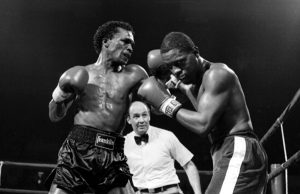
Unsatisfied with his performance vs. Kevin Howard (right), Leonard re-retired after his 1984 comeback. Photo / Ring-Getty collection
moment Howard scored a shocking fourth-round knockdown, and though Leonard went on to stop Howard in the ninth, he informed the world – and Hagler – that he was returning to the safer side of the ring.
“As of this moment, I am retired,” he said at the post-fight presser. “There’s no sense in fooling myself or anyone else. It’s just not there. I just can’t go on and humiliate myself. I fought with apprehension. I had fear for my eyes. I had fear for my whole body. But now I am content. I did try.”
On the other hand, Hearns continued to compete – and to win. After the proposed May 1982 fight with Hagler fell through, Hearns outpointed Jeff McCracken over 10 rounds in July, dethroned WBC super welterweight champion Benitez in December by unanimous decision and notched points wins over Murray Sutherland and Luigi Minchillo. Hearns had changed his violent “Hit Man” moniker to the tamer “Motor City Cobra” at the request of an image-conscious mayor of Detroit, and these route-going performances aptly represented his change of mindset. But when Hearns signed to fight Duran – still the WBA super welterweight champion despite his loss to Hagler – he announced he would once again become the “Hit Man” and predicted that he would destroy the Panamanian legend inside of two rounds.
The boldness of that prediction could not be understated, for Duran boasted one of history’s sturdiest chins. In 82 fights, Duran had been floored only twice thanks to first-round left hooks by Esteban DeJesus in each of their first two meetings, and the latter had occurred more than 10 years earlier. Since then, he had taken the best shots of all who came before him – including Leonard and Hagler – and there was every reason to believe he would do the same against Hearns.
But on fight night, Duran ended up being a two-time loser. The first occurred the moment he stepped inside the ring at Caesars Palace to meet Hearns, for with that act he officially surrendered his WBA title for not fighting mandatory challenger (and Hearns stable mate) Mike McCallum while the second unfolded in astonishing fashion once the fight commenced.
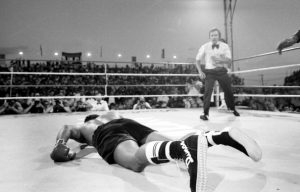
Hearns backed up his bold prediction of halting Duran within two rounds, which made many wonder if he could do the same to Hagler. Photo / The Ring-Getty collection
From the moment he stepped inside the ring, the fire that had raged in Duran was a mere pilot light. He was docile, deferential and out of sorts while Hearns was confident, powerful, and ultimately unstoppable. By scoring two knockdowns in round one, Hearns equaled the knockdown total scored by all of Duran’s previous opponents, but it was the right cross that smashed into Duran’s jaw in round two that told the world that the “Hit Man” was truly back. Following a wild exchange along the ropes, Hearns connected with arguably the best right hand of his boxing life, a nuclear-tipped bomb that instantly separated Duran from his consciousness. Duran pitched forward and struck the canvas face first, prompting referee Carlos Padilla to stop the fight without a count. When Duran regained a semblance of awareness, he was heard to ask “que yo hice malo?” – “what did I do wrong?”
But the story wasn’t about what Duran did wrong, it was about what Hearns did right – with his right.
“You all thought I was crazy picking a second-round knockout,” Hearns said at the post-fight press conference. “But I was deadly serious. I couldn’t just win, I had to win big because I was fighting a legend. And Roberto Duran is a legend. The ‘Hit Man’ was on vacation, but now he’s back. Now I want Marvin Hagler. I just wonder if he still wants me.”
Although Hearns’ words expressed doubt about Hagler’s desire to fight him, one had to believe that in the deepest recesses of his mind, he knew that the champion named “Marvelous” hungered for the opportunity to add another superstar scalp to his trophy room.
Because my C-band satellite dish lacked the equipment to descramble the live feed of Hearns-Duran, I was solely dependent on the ringside commentary and the roar of the crowd to decipher what was occurring inside the ring. The news of Duran being knocked down so quickly in round one stunned me, and the reality of him hitting the canvas a second time moments later was nothing short of surreal. Then came the final blow, a blow that ignited a bloodthirsty roar from the crowd and the instant stoppage. Only when the fight was replayed on CBS did I get the full scope of what happened, and what I saw was beyond my comprehension.
I was left with mixed feelings. On the one hand, my interest in boxing was sparked by Duran’s second fight with DeJesus, and I harbored an affection and appreciation for him because of that. On the other hand, I was thrilled not only for Hearns – a fighter I liked and respected – but also for the very real prospect that Hagler and Hearns would soon be sharing a ring.
Hagler filled in the final pieces of this puzzle by struggling past Juan Domingo Roldan in March 1984, then flattening Mustafa Hamsho inside of three rounds the following October to solidify his standing as not just the world’s best middleweight, but also the best pound-for-pound boxer on earth. As for Hearns, he proved the “Hit Man” persona was here to stay as he crushed third-ranked Fred Hutchings to retain his WBC super welterweight championship.
The stage was finally set. On Tax Day 1985 at the outdoor parking lot erected near Caesars Palace, Marvelous Marvin Hagler and Thomas “Hit Man” Hearns would vie for the undisputed middleweight championship of the world. I – and all other sports aficionados – could hardly wait for April 15 to arrive.
*
Lee Groves is a boxing writer and historian based in Friendly, West Virginia. He is a full member of the BWAA, from which he has won 18 writing honors, including first-place awards in 2011 and 2013. He has been an elector for the International Boxing Hall of Fame since 2001 and is also a writer, researcher and punch-counter for CompuBox, Inc. He is the author of “Tales from the Vault: A Celebration of 100 Boxing Closet Classics” (available on Amazon) and the co-author of “Muhammad Ali: By the Numbers” (also available on Amazon). To contact Groves use the email [email protected] or send him a message via Facebook.
READ THE LATEST ISSUE OF THE RING FOR FREE VIA THE NEW APP NOW. SUBSCRIBE NOW TO ACCESS MORE THAN 10 YEARS OF BACK ISSUES.















